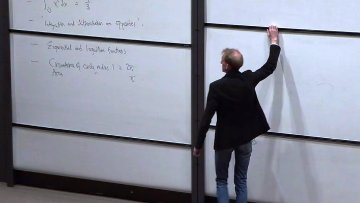Back in October, for the first time, we filmed an actual student lecture, Vicky Neale's lecture on 'Complex Numbers.' We wanted to show what studying at Oxford is really like, how it is not so different to school while at the same time taking things to a more rigorous level. Since we made the film available, over 375,000 people have watched some of it.
Persistence of Random Structures
Abstract
This talk will cover the connections of persistence with the topology of random structures. This includes an overview of various results from stochastic topology as well as the role persistence ideas play in the analysis. This will include results on the maximally persistent classes and minimum spanning acycles/generalised trees.
Chasing memories
Abstract
Short- and long-term memories are distinguished by their forgettability. Most of what we perceive and store is lost rather quickly to noise, as new sensations replace older ones, while some memories last for as long as we live. Synaptic dynamics is key to the process of memory storage; in this talk I will discuss a few approaches we have taken to this problem, culminating in a model of synaptic networks containing both cooperative and competitive dynamics. It turns out that the competitionbetween synapses is key to the natural emergence of long-term memory in this model, as in reality.
References
Mehta, Anita. "Storing and retrieving long-term memories: cooperation and competition in synaptic dynamics." Advances in Physics: X 3.1 (2018): 1480415.
Multiparameter persistence vs parametrised persistence
Abstract
One of the key properties of 1-parameter persistent homology is that its output can entirely encoded in a purely combinatorial way via persistence diagrams or barcodes. However, many applications of topological data analysis naturally present themselves with more than 1 parameter. Multiparameter persistence suggests itself as the natural invariant to use, but the problem here is that the moduli space of multiparameter persistence diagrams has a much more complicated structure and we lack a combinatorial diagrammatic description. An alternative approach was suggested by work of Giansiracusa-Moon-Lazar, where they investigated calculating a series of 1-parameter persistence diagrams as the other parameter is varied. In this talk I will discuss work in progress to produce a refinement of their perspective, making use the Algebraic Stability Theorem for persistent homology and work of Bauer-Lesnick on induced matchings.
Sheaf Laplacians as sums of semidefinite matrices
Abstract
The class of sheaf Laplacians can be characterized as the convex closure of a certain set of sparse semidefinite matrices. From this viewpoint, the study of sheaf Laplacians becomes a question of linear algebra on sparse matrices. I will discuss the applications of this perspective to the problems of approximating, sparsifying, and learning sheaves.


